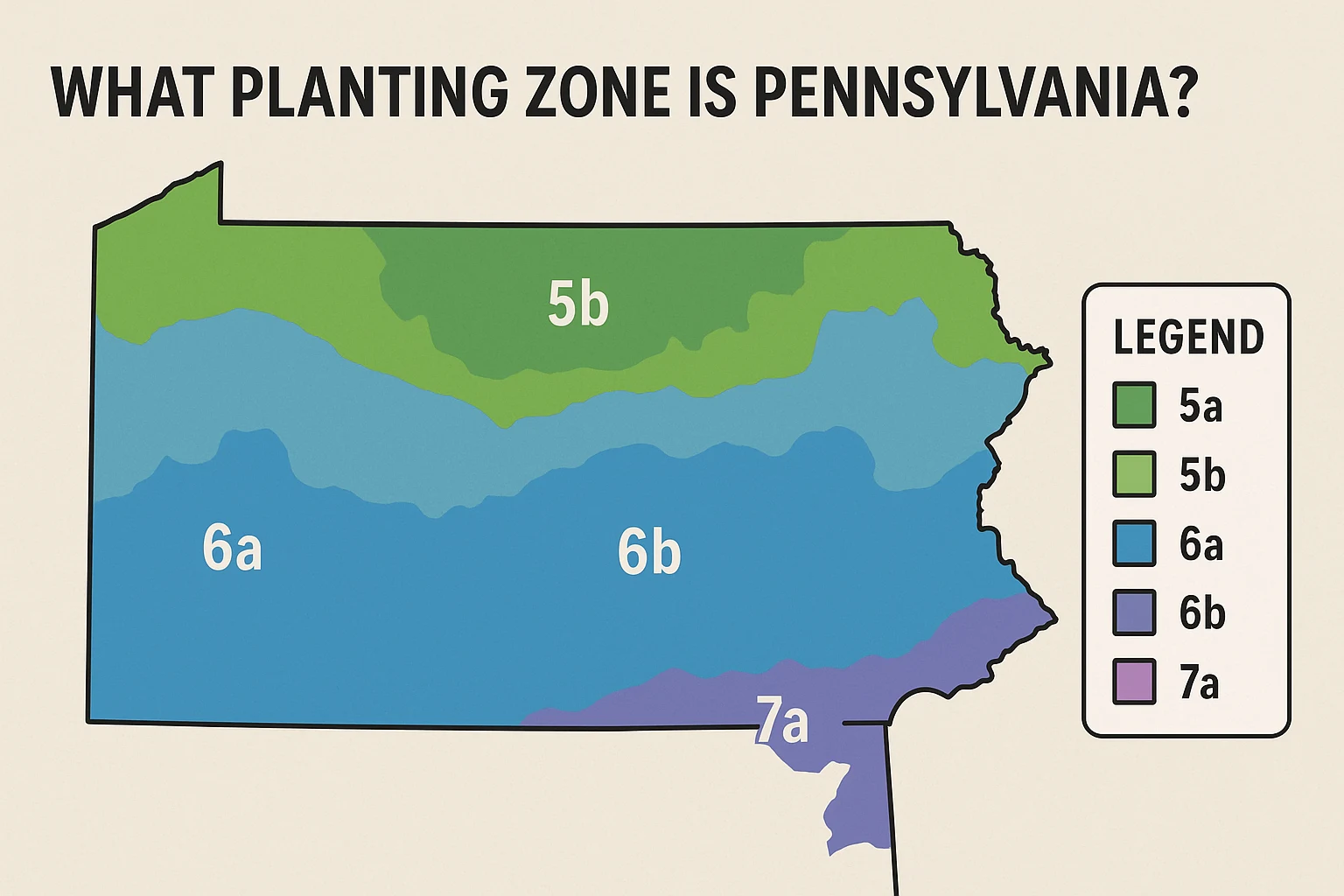What Planting Zone is Pennsylvania?[Map, Cities, and Growing Tips]

If you’re planning a garden or landscaping project in the Keystone State, you might be asking: What planting zone is Pennsylvania? Knowing your planting zone is crucial for selecting plants that will survive the winter and thrive year-round.
In this guide, we’ll explore Pennsylvania’s planting zones in detail, break it down by region and city, and share tips for successful gardening based on your zone.
🌱 What Planting Zone is Pennsylvania?
Pennsylvania’s planting zones range from 5a to 7b, with most of the state falling within zones 6a and 6b. Here’s how it breaks down:
| Region | USDA Planting Zone |
|---|---|
| Northern Pennsylvania (e.g., Bradford, Warren) | Zone 5a–5b |
| Central Pennsylvania (e.g., State College, Altoona) | Zone 6a–6b |
| Southern Pennsylvania (e.g., Philadelphia, Harrisburg, Lancaster) | Zone 7a–7b |
These zones are based on the average minimum winter temperatures, helping you choose plants that can withstand Pennsylvania’s climate.
📍 Pennsylvania Planting Zones by City
To answer what planting zone is Pennsylvania by city, here’s a quick reference:
| City | Planting Zone |
|---|---|
| Philadelphia | Zone 7b |
| Pittsburgh | Zone 6b |
| Harrisburg | Zone 7a |
| Scranton | Zone 6a |
| Allentown | Zone 6b |
| Erie | Zone 6b |
| Reading | Zone 6b |
| State College | Zone 6a |
| York | Zone 7a |
For gardeners, understanding what planting zone is Pennsylvania for your specific city can help prevent planting mistakes and save time and money.
🌡️ Why Planting Zones Matter in Pennsylvania?
Pennsylvania’s planting zones are essential for:
- Choosing cold-hardy perennials
- Timing vegetable plantings to avoid frost
- Protecting sensitive plants during harsh winters
In areas like Erie (Zone 6b), winter can bring much colder temperatures compared to Philadelphia’s milder Zone 7b. So knowing what planting zone is Pennsylvania in your area directly impacts plant survival.
🧠 Example: Growing Tomatoes in Pennsylvania
In Zone 5a (northern PA), tomatoes shouldn’t go in the ground until late May. But in Zone 7b (Philadelphia), you can often plant tomatoes by early May. The difference in Pennsylvania planting zones can extend your growing season by several weeks.
📅 When to Plant in Pennsylvania?
| Crop Type | Zone 5a Start | Zone 6b Start | Zone 7b Start |
|---|---|---|---|
| Cool-season veggies (lettuce, spinach) | Apr–May | Mar–Apr | Feb–Mar |
| Warm-season veggies (tomatoes, peppers) | Late May | Early May | Late April |
| Perennials & shrubs | Spring or fall | Spring or fall | Fall (ideal) |
Understanding what planting zone is Pennsylvania helps you fine-tune this schedule for your garden.
💡 Gardening Tips for Pennsylvania’s Climate
Here are key strategies for thriving in Pennsylvania’s planting zones:
✅ Mulch generously to protect roots in winter.
✅ Start seeds indoors to extend short growing seasons.
✅ Choose native species adapted to Pennsylvania’s zone variations.
✅ Watch for late frosts in zones 5a–6a, especially in valleys and higher elevations.
Knowing what planting zone is Pennsylvania where you live also helps you choose trees, shrubs, and flowers that will last year after year.
📍 Find Your Exact Pennsylvania Planting Zone
For the most accurate result, check the official USDA Plant Hardiness Zone Map and enter your zip code. Even within the same county, what planting zone is Pennsylvania for your address may vary due to elevation and microclimates.
🧮 Recommended Tools for Pennsylvania Gardeners
- Soil Volume Calculator – Know exactly how much soil you need for raised beds.
- Plant Spacing Calculator – Prevent overcrowding and maximize yield.
- Indoor Plant Watering Calculator – Perfect for your houseplants or container garden.
These can save you time and prevent costly mistakes when planting in Pennsylvania’s variable zones.
✅ Conclusion: What Planting Zone is Pennsylvania?
In summary, Pennsylvania’s planting zones range from 5a to 7b, with the majority of gardeners working within zones 6a and 6b. Northern Pennsylvania includes zones 5a and 5b, central Pennsylvania is mostly zone 6a–6b, while southern Pennsylvania—especially around Philadelphia—is in zones 7a and 7b.
By knowing what planting zone is Pennsylvania where you live, you’ll make smarter plant choices, better protect your garden from frost, and enjoy more reliable harvests.
